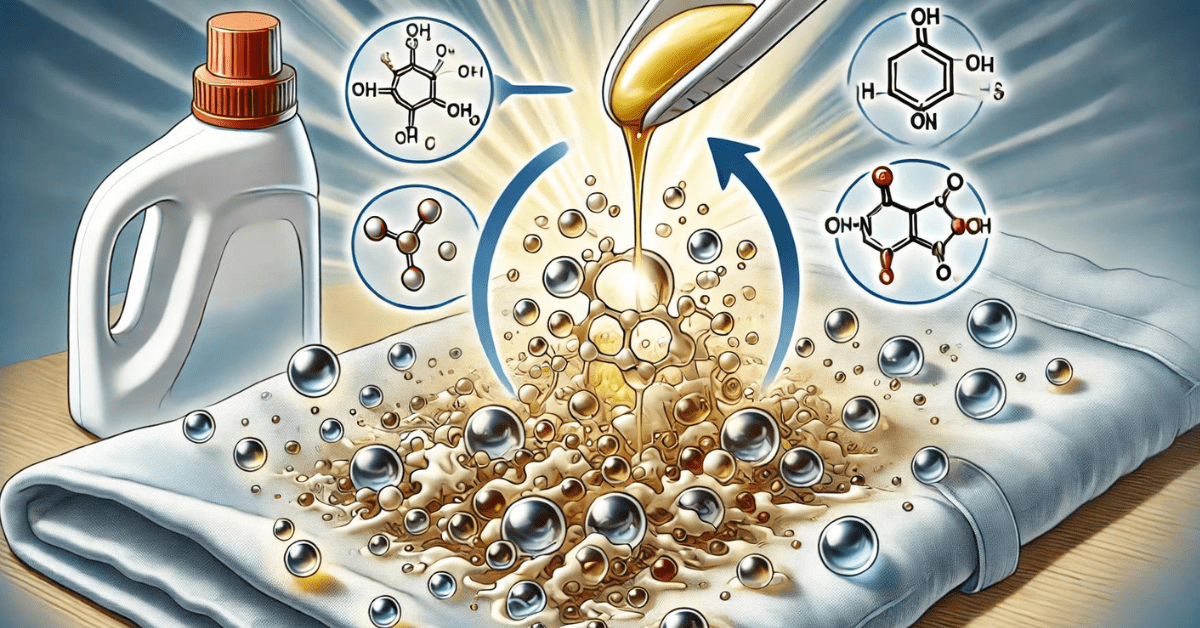Getting oil stains on your clothes sucks, but sometimes it’s unavoidable. If you work in a kitchen or garage you know how difficult it can be to remove grease and oil stains from clothes and fabric.
While there are plenty of old wives’ tales about getting rid of oil stains, in this article we’re busting out our year 10 science textbooks to understand what’s happening at a chemical level. Then we’ll use that information to find the best methods to remove those stubborn stains.
Remember before attempting to remove any stain, check the tag for laundry care instructions to ensure that the method you are using is suitable and won’t damage the garment. Always test any treatment on an inconspicuous area of the fabric first to ensure it does not cause damage or discolouration.
Click here to skip to our instructions for removing oil stains.
The science of removing oil stains from clothes and fabric
When removing oil stains from clothes and fabrics several chemical reactions and processes occur. These mainly involve surfactants, solvents, and sometimes enzymes.
Surfactants found in detergent and laundry soap
Surfactants are compounds that lower the surface tension of water allowing it to spread more effectively. They are made of two parts, a hydrophilic head (part that attracts water) and a hydrophobic tail (part that repels water).
When surfactants are added to water with oil in it the following chemical reaction occurs:
- The hydrophobic tail binds to the oil molecules because it is attracted to non-polar substances like oil.
- The hydrophilic head remains in the water.
- Michelle (oil trapped within surfactants) forms when the surfactants surround the oil molecules with their hydrophobic tails inward and hydrophilic heads outward. This emulsifies the oil, lifting it from the clothing or fabric and dispersing it in the water and washing it away during the wash cycle.
Enzymes found in heavy-duty detergents
Enzymes are biological catalysts that speed up chemical reactions. In laundry detergents, enzymes like lipases are used to break down fats and oils into simpler, water-soluble components.
Lipase enzymes break down triglycerides, the main components of oils and fats, into glycerol and free fatty acids.
Using solvents to remove oil stains from clothes
Solvents (sometimes called degreasers) like methylated spirits dissolve oils by interacting with their non-polar molecules. These solvents disrupt the cohesive forces within the oil, causing it to dissolve into a solution that can then be washed away.
Using absorbent powders to remove oil stains
Absorbent powders like baking soda or cornstarch physically bind to the oil, lifting the oil stain from the clothing or fabric. Powder particles have a large surface area that allows the particles to attract and hold the oil molecules through Van der Waals forces.
Is there a difference between removing cooking oil stains and motor oil stains?
The processes for removing cooking oil stains and motor oil stains from clothes are similar.
Both involve needing to break down and remove oil from fabric. However, some differences in the composition of these oils may require you to take some additional steps to completely remove the stain.
What’s different?
Composition of Oils:
- Cooking Oil: Typically consists of triglycerides and is relatively straightforward to break down using surfactants and enzymes.
- Motor Oil: Contains a mix of hydrocarbons, additives, and sometimes particulate matter. It can be more stubborn and might require stronger solvents.
Pre-Treatment:
- Cooking Oil: Dish soap is usually sufficient for pre-treating cooking oil stains.
- Motor Oil: Pre-treatment with a stronger degreaser or solvent (like rubbing alcohol, mineral spirits, or a commercial engine degreaser) may be necessary due to the more complex composition of motor oil.
Cleaning Agents:
- Cooking Oil: Enzyme-based detergents are effective because they break down the triglycerides in cooking oils.
- Motor Oil: Heavy-duty detergents specifically formulated for greasy, oily stains are often more effective. These might include detergents with more robust surfactants and possibly stronger solvents.
Multiple Wash Cycles:
- Cooking Oil: Often removed with a single wash cycle if treated promptly.
- Motor Oil: May require multiple treatments and wash cycles to fully remove, especially if the stain has set or if particulate matter is present.
The process for removing grease and oil stains from clothes
Here is Nina’s Laundrette’s method for removing grease and oil stains from clothing and fabric.
- Blot the stain
At the earliest possible opportunity use a paper towel or clean rag to blot the stain and remove as much of the oil as possible.
- Apply absorbent powder and let it sit
Apply an absorbent powder (baking soda, cornstarch, salt) to soak up any remaining oil that couldn’t be removed from blotting and allow it to sit.
- Brush off the powder
Brush away the absorbent power once it has solidified.
3.1 Pre-treat with a solvent or commercial degreaser
If you are working with a motor oil stain or a particularly stubborn oil stain, apply a solvent or degreaser as a pre-treatment before loading it in the washing machine.
- Apply dish soap and gently rub it in
Apply dish soap or laundry detergent with a surfactant in it to the stain and rub it in.
- Wash on a hot water setting
Washing the fabric in the hottest water safe for the material helps dissolve and remove the oil.
- Wash with a heavy-duty detergent
Include a laundry detergent that includes enzymes that break down fats and oils
- Repeat the process if necessary (optional)
For particularly nasty stains you may need to repeat this process a few times to get the desired results

